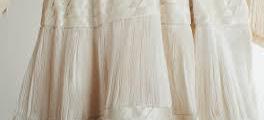
3 minute read
Fashion History 101 Sybil Connolly: The Waterford woman who put Irish fabrics on an international stage
There are many things that us Irish are known for around the world. From winning the Eurovision umpteen times to drinking Guinness like it’s water, it’s fair to say that the world has shaped its own version of what a stereotypical Irish person is like. However, one thing that we are not renowned for worldwide is our contribution to the global fashion industry. Despite our rich history of being skilled in certain areas of creativity such as art and poetry, when it comes to fashion there is no doubt that Ireland is typically overshadowed by other European countries like Italy or France, who have both earned their stripes as fashion capitals of the world. But of course, like anything, there are always exceptions to the rule. Enter Sybil Connolly.

Advertisement

Connolly, a dark-haired beauty who grew up in Waterford in the 1930s, is owed a huge debt by the Irish fashion industry for bringing Irish fabrics to the attention of the public. Beginning as a young, half-qualified dressmaker working in Richard and Allen’s department store on Grafton Street, Connolly’s journey to success was one of both extreme luck and extreme talent. For the first thirteen years of her career Connolly worked diligently and quietly in the backrooms of Richard and Allen, until the firm’s head designer abruptly resigned from his position in 1952 and left Connolly to take the reins.
Unlike other designers of her era who favoured fabrics imported from abroad, Connolly decided to use her first collection with Richard and Allen as an excuse to showcase the quality and noteworthiness of native Irish materials. This was an extremely bold move on Connolly’s behalf, as it was seen as fashionable and more refined to import fabrics from fashion houses in cities like Paris or Milan.
However, Connolly’s risk definitely paid off. Her brave use of native Irish fabrics was praised warmly by both critics and the public alike and, as a result, Connolly was subsequently given the opportunity to launch her very own clothing label in the U.S. From there, Connolly’s career went from strength to strength. As a glamorous young woman taking the fashion world by storm, her rise to fame gathered a lot of interest from the public. In 1954, a feature in Housewife magazine wrote: “this fairytale person has looks. Short curling dark hair. Eyes the brown of peat...And a model figure too.”
Despite the rocketing success of Connolly’s career and the lack of financial constraints that she enjoyed as a world-renowned designer, Connolly continued to incorporate Irish materials in her designs. She was a particular fan of using Irish linen, which was then pleated, and used in both dresses and skirts alike. This material was extremely popular with Connolly’s audience, as it could be packed away in wardrobes and shoved into boxes without needing to be ironed afterwards.
Another Irish material that Sybil Connolly was responsible for bringing into the limelight was Donegal tweed. Now a booming industry in Ireland, Donegal tweed has been around for centuries but only really found its place on the map when Connolly started using it in her designs. Enamoured by the potential of such a durable fabric, Connolly took traditional Donegal tweed and updated the material by styling it in new cuts and beautifully rich colours. Thanks to Connolly, in the 1950s tailored suits made of Donegal tweed were in vogue across the globe and, as a result, business boomed for the many small, family-run woollen mills dotted across the country.
As Connolly’s fame continued to increase, she (unsurprisingly) began to attract some seriously high-profile clients. Throughout her career, Connolly dressed some of the most iconic figures of the twentieth century, notably Julie Andrews and Elizabeth Taylor. In 1970, First Lady Jacqueline Kennedy posed for an official White House portrait wearing one of Connolly’s pleated linen creations.
Today, the mark that Sybil Connolly left on the global fashion industry can still be felt. It is because of her work with Irish fabrics that Ireland has earned itself a good reputation as a producer of beautiful natural materials, and as a result Irish fabrics have been included in some of the most unforgettable designs the world has seen to date. In 1981, Princess Diana’s iconic wedding dress featured Carrickmacross lace from county Monaghan. This same lace was also used in the elegant dress that Kate Middleton wore on her wedding day back in 2011.
Years on from her death, the debt that the Irish fashion industry owes to Sybil Connolly still cannot be repaid. As the Waterford woman who put Irish materials on the map, Sybil Connolly, we salute you.
WORDS BY MILLIE BRENNAN










